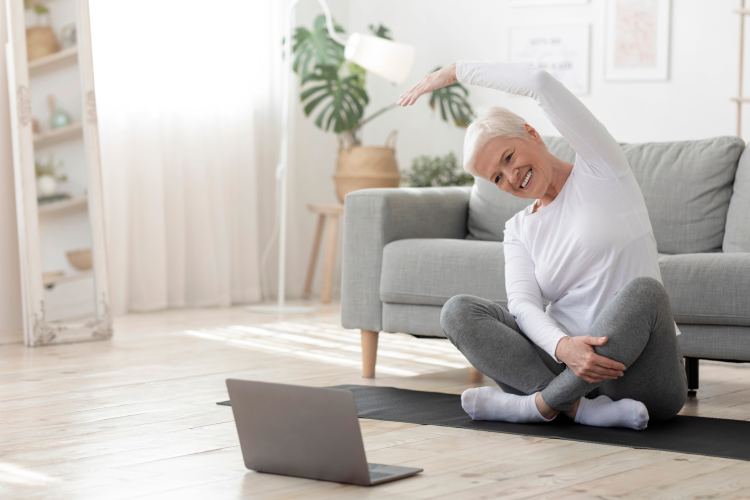Quelle perception avez-vous de l’activité physique? Pour plusieurs, l’activité physique se limite à la participation à un sport organisé, ou encore, suivre un programme d’exercice dans un gym. Cette perception pose quelques problèmes lorsque l’on désire encourager notre clientèle un peu plus âgée à être actifs. Dès que l’on mentionne le terme activité physique, ils s’imaginent qu’ils doivent se remettent à faire de la course à pied, chose qui bien évidemment leur semble la plupart du temps impossible. Comme tout être humain, face à l’impossible, plusieurs de nos aînés se découragent et perdent le goût et l’intérêt de faire quelconque activité qui ferait en sorte qu’ils bougeraient leur corps puisqu’ils n’y voient pas les avantages. Et pourtant, il y en a plusieurs, la plus importante d’entre elles étant la préservation de votre autonomie!
Dans cet article, nous élaborerons comment le fait de rester actif vous permet de préserver votre autonomie, et ce, même après une opération, une blessure ou une chute.
Tout d’abord, nous aimerions vous rassurer. L’activité physique ne se résume qu’à une seule chose : Bouger.
C’est simple non? Donc, en d’autres termes, si vous :
- allez prendre une marche,
- passez votre balayeuse,
- faites du jardinage,
- jouez avec vos petits-enfants,
- épousseter vos meubles,
vous êtes, dans les faits, en train de faire de l’activité physique. Bien entendu, certains critères devraient être répondus afin que cette activité physique soit considérée comme efficace pour votre santé et bien-être, mais nous y reviendrons sous peu.
Comme vous pouvez le voir, nul besoin de vous inscrire à un programme d’entraînement pour faire de l’activité physique. Cela étant dit, vous vous demandez peut-être pourquoi vous devriez vous mettre à bouger.
Voici quelques raisons :
1. Conserver votre autonomie fonctionnelle
Ce qu’il faut retenir ici, c’est que l’on perd ce que l’on n’utilise pas. Vos muscles sont faits pour bouger. Lorsque vous ne les bougez plus, vos muscles s’atrophient et vous perdez de la force et de la mobilité dans vos mouvements. Le résultat? Peut-être avez-vous de la difficulté à lever une boîte au-dessus de votre tête pour la placer sur l’étagère ou encore peut-être devient-il de plus en plus difficile pour vous de rester debout pendant de longues périodes ? Rester actifs vous permet de continuer à participer aux tâches de la vie quotidienne ainsi que de continuer à participer à vos activités sociales.
2. Prendre soin de votre cœur et de vos poumons
Bouger permet d’activer vos systèmes cardiaques et respiratoires. Lorsque vous faites de l’activité physique, votre cœur pompe votre sang plus rapidement ce qui permet une oxygénation plus fréquente de vos muscles. Des muscles oxygénés sont des muscles qui restent en santé et donc qui répondent mieux lorsqu’on leur demande de faire un effort.
3. Protéger vos os et vos articulations
Lorsque vous prenez soin de vos muscles, vous vous assurez aussi de prendre soin de vos os et de vos articulations. Des muscles renforcés les protègent en cas de chute ou d’efforts physiques plus importants. De plus, le fait de bouger régulièrement lubrifie vos articulations et diminuent les douleurs en autre causer par l’arthrose, le vieillissement normal des os.
4. Prendre soin de votre cerveau
La circulation accrue du sang, et donc d’oxygène, qui se produit lors de l’activité physique ne se limite pas qu’aux muscles! Comme vous l’aurez deviné, elle permet aussi une bonne oxygénation au niveau du cerveau ce qui le garde en santé et aide à prévenir ou ralentir le développement d’une démence.
Tel que mentionné plus tôt, il existe certaines recommandations au niveau de l’activité physique qui vous permettra d’en retirer le plus de bénéfice possible.
Idéalement vous devriez suivre les consignes suivantes :
- Effectuer un minimum de 150 minutes d’activité physique modéré** par semaine;
- Chaque séance d’activité physique devrait durer un minimum de 10 minutes.
** Un effort modéré se définit comme étant un effort durant lequel vous avez chaud et que vous vous sentez un peu essoufflé.
Bouger pour accélérer
Les bénéficies ci-haut ainsi que les recommandations que nous vous faisons vous semblent raisonnable? Tant mieux! Nous espérons qu’ils vous ont motivés à intégrer plus de mouvement dans votre vie. Qu’en est-il cependant de l’activité physique à la suite d’une opération, d’une blessure ou d’une chute? La tendance naturelle est de rester au lit et de se reposer le plus possible. Cependant, la reprise de vos capacités physiques dépend de la vitesse à laquelle vous vous remettez à utiliser vos muscles. Dans les faits, plus on vieillit, plus la récupération est longue et plus il devient essentiel de reprendre rapidement, quoique progressivement, nos activités quotidiennes et nos bonnes habitudes de vie.
Pourquoi croyez-vous que les gens tardent à recommencer à bouger? Croyez-vous que ce soit par paresse ou par manque de motivation? Selon notre expérience ce ne sont pas les facteurs déterminants.
Lorsque vous marchez, réfléchissez-vous au pas que vous devez effectuer? Qu’en est-il de monter les escaliers, rentrer et sortir de la voiture? Est-ce que ces mouvements vous viennent naturellement? Nous croyons que les gens tardent à recommencer à bouger puisqu’ils croient qu’ils pourront reprendre facilement leurs activités quotidiennes.
La raison? Parce que cela fait plusieurs années qu’ils les font sans réfléchir. À l’opposé, la plupart d’entre eux ne connaissent pas le temps ou l’effort nécessaire à la rééducation de ces activités. Nous espérons donc qu’en partageant cette information avec vous, vous serez mieux préparé si une telle situation se présente.
Il y a des façons graduelles et sécuritaires de réintroduire le mouvement à la suite d’une période d’inactivité physique. Nous vous encourageons grandement à faire appel à un professionnel de la physiothérapie pour vous assister dans cette démarche.






